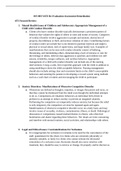RN MH V ATI Re-Evaluation Assessment Remediation ATI Focused Review:
1.Mental Health Issues of Children and Adolescents: Appropriate Management of a Child with Conduct Disorder
a.Clients who have conduct disorder typically demonstrate a persistent pattern of behavior that violates the rights of others or rules and norms of society. Categories
of conduct disorder in volve aggression to people and animals, destruction of property, deceitfulness or theft, and serious violation of rules. Contributing factors
of conduct order can include but is not limited to parental rejection and neglect, physical or sexual abuse, lack of supervision, and large family size. Examples of manifestations that can be seen with conduct disorder consist of bullying, threatening, and intimidating others, demonstrating a lack of remorse or care for the feelings of others, believes that aggression is justified, and exhibits low self-
esteem, irritability, temper outbursts, and reckless behavior. Appropriate management of a child with conduct disorder can include any of the nursing interventions: Using a calm, firm respectful approach with the child in addition to using modeling to show the child acceptable behavior. Nursing management should also include setting clear and consistent limits on the child’s unacceptable behaviors and assisting the parents in developing a reward system using methods such as a wall chart or tokens and encouraging the child to participate. 2.Anxiety Disorders: Manifestations of Obsessive-Compulsive Disorder
a.Obsessions are defined as thoughts, impulses, or images that persist and recur, so that they cannot be dismissed from the mind even though the individual attempts to do so. Compulsions are ritualistic behaviors an individual feels driven to perform in an attempt to reduce anxiety or prevent an imagined calamity. Performing the compulsive act temporarily reduces anxiety, but because the relief is only temporary, the compulsive act must be repeated again and again. Manifestations of obsessive-compulsive disorder occur on a daily basis and may involve issues of sexuality, violence, contamination, illness, or death. Pathological
obsessions or compulsions caused marked distress to clients, who often feel humiliation and shame regarding these behaviors. The rituals are time-consuming and interfere with normal routines, social activities, and relationships with others. 3.Legal and Ethical issues: Contraindications for Seclusions
a.It is inappropriate for seclusion or restraints to be used for the convenience of the staff, punishment for the client, for clients who are extremely physically or mentally unstable, or lastly for clients who cannot tolerate the decreased stimulation of a seclusion room. Restraints should also never interfere with treatment, they should be easy to remove or change, fit properly and be discreet as possible and restrict movement as little as necessary. In an emergency situation when there is immediate risk to the client or others, nurses can place restraints on a client. However, the nurse must obtain a prescription from the provider as soon as possible according to the facility’s policy which is usually within 1 hour.
4.Medications for Substance Use Disorders: Medications for Acute Alcohol Withdrawal a.The first line of treatment of alcohol withdrawal is Benzodiazepines (ex. Chlordiazepoxide, Diazepam, Lorazepam). The intended effects of benzodiazepines for withdrawal from alcohol consist of maintaining client vital signs, decrease the risk of seizures, and decrease the intensity of withdrawal manifestations. Adjunct medications sometimes used in treatment with benzodiazepines include carbamazepine, clonidine, propranolol, and atenolol. The
intended effect of Carbamazepine is to decreased seizures, whereas the intended effects of Clonidine, Propranolol, and Atenolol are to decrease autonomic responses in the client (ex. decrease BP, HR). Clonidine and Propranolol also help
in decreasing cravings. Following withdrawal, abstinence maintenance can be treated with Disulfiram, Naltrexone, and Acamprosate. Learning Activities in PowerPoints
Personality Disorder Learning Activity Review Questions: 1.Define Antisocial Personality Disorder (APD)
a.Antisocial personality disorder is characterized by the disregard for others with exploitation, lack of empathy, repeated unlawful actions, deceit, failure to accept personal responsibility, evidence of conduct disorder before age 15, sense of entitlement, nonadherence to traditional morals and values, verbally charming and
engaging and lastly, manipulative, impulsive, and seductive behaviors. The Diagnostic and Statistical Manual of Mental Disorders (DSM 5) classifies all ten personality disorders into three clusters (A, B, and C). Antisocial personality disorder falls into 1 of 4 cluster-B disorders, which includes borderline, narcissistic, and histrionic personality disorders. All of these disorders characteristically present with dramatic, emotional, and unpredictable interactions
with others.
2.What are some of the diagnostic criteria for personality disorders? The DSM-5 diagnostic criteria for Antisocial Personality Disorder includes a
a.A pervasive pattern of disregard for and violation of the rights of others, since age
15 years, as indicated by three (or more) of the following:




